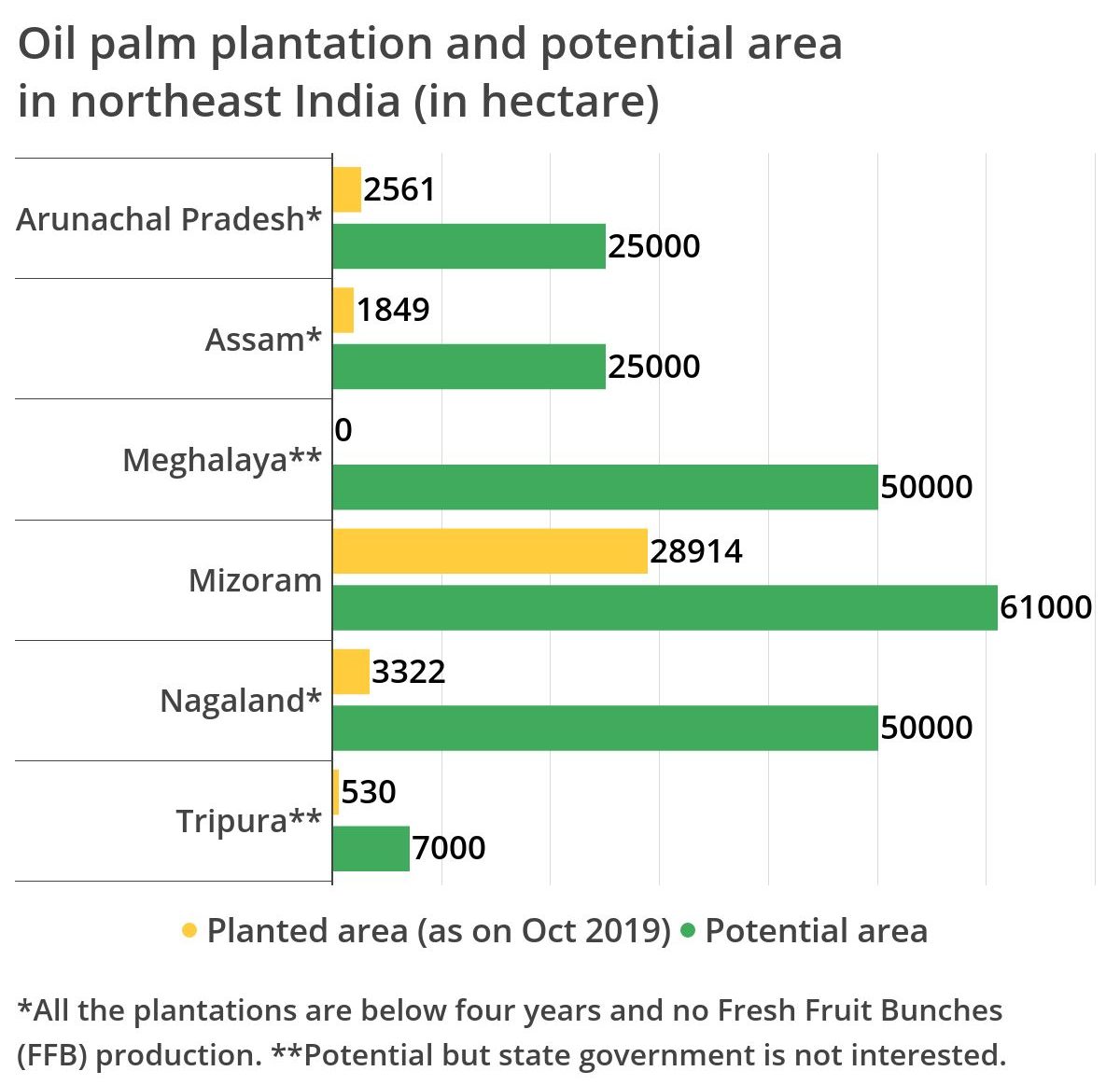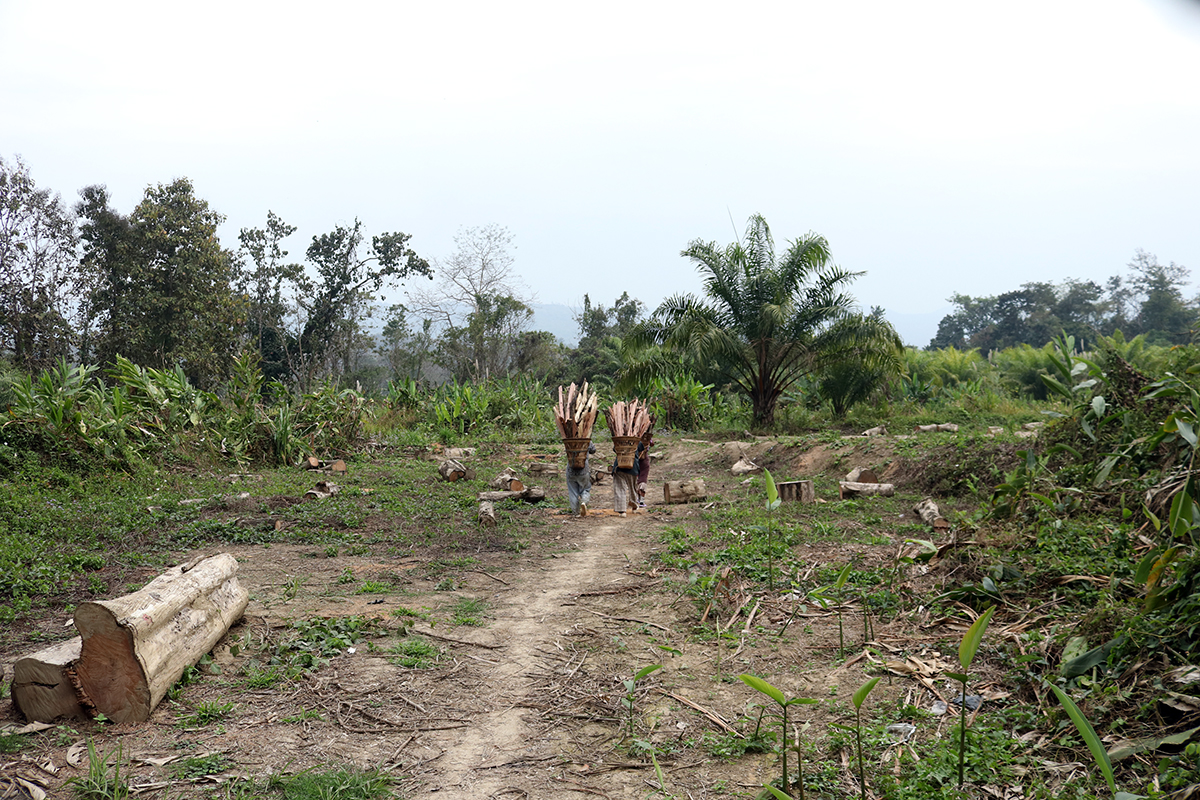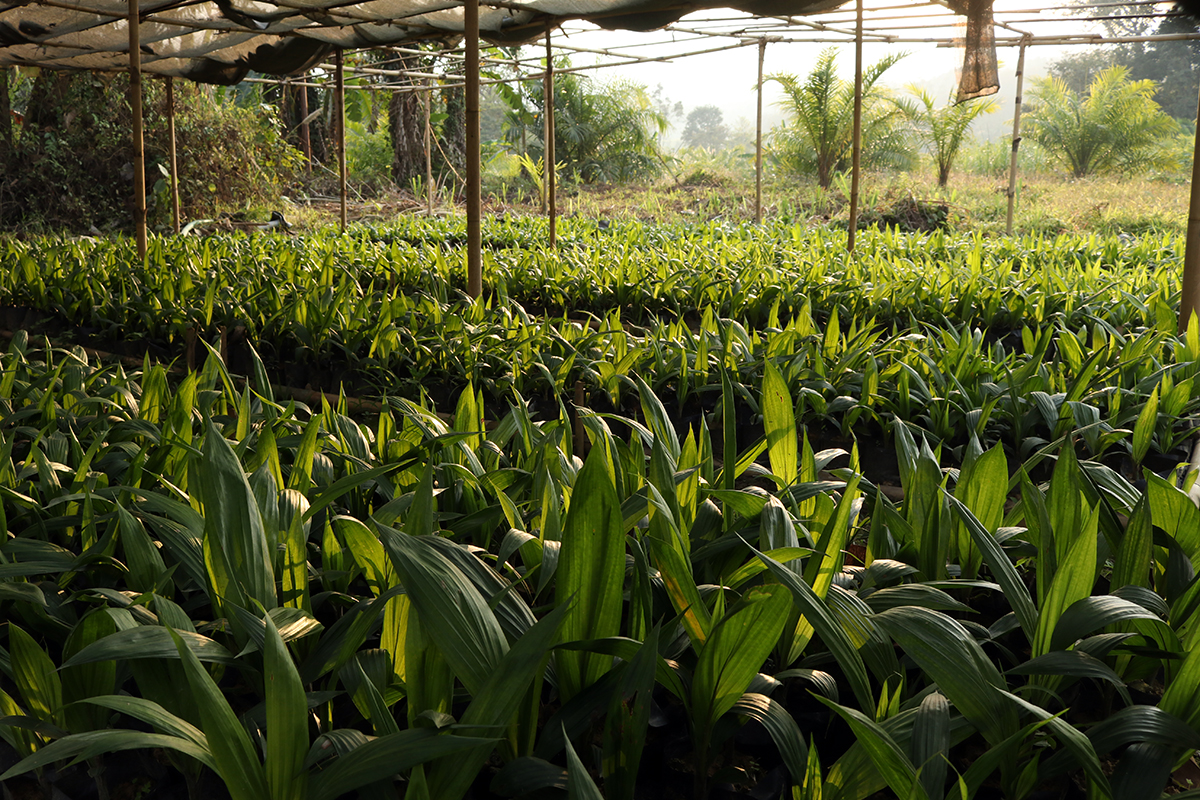- In Mizoram, palm oil has been considered a crop of immense economic promise. The state has 78 percent of the total land under oil palm cultivation in northeast India.
- However, the threat to biodiversity and soil fertility due to palm oil, has environmentalists, economic planners and farmers divided regarding the expansion of this crop in the biodiversity-rich state.
- The state government has been aggressively promoting oil palm cultivation since 2005 under its New Land Policy. Recently, the union cabinet also approved the National Mission on Edible Oils-Oil Palm with a special focus on the northeast region and the Andaman and Nicobar Islands.
Vanlaldika, a temporary forest guard in Dampa Tiger Reserve, one of the last remaining tiger habitats in Mizoram, has been cultivating oil palm for the past seven years. Vanlaldika, hails from Dampa Rengpui, a hamlet in the buffer zone of the tiger reserve and owns a field of 200 oil palm trees. He says, “Palm oil fields dot the buffer zone as well as the core area of the Dampa Tiger Reserve. People in my village have been cultivating oil palm for the last ten years.”
Vanlaldika said that forest guards do not get remunerated regularly and thus have to indulge in alternate occupations like cultivating palm oil, areca nuts, rearing animals, running shops, among others, to keep their families afloat.
However, the lack of a collecting centre in the vicinity is a challenge for farmers like him. “To sell palm oil fruits, we have to drive 30 kilometres to West Phaileng in Mamit district, incurring heavy transportation charges. Because of this, many farmers have given up the cultivation of palm oil and switched to areca, pineapple and banana which are easier to sell. But for me, it is difficult to make the switch because I was so emotionally invested in this,” Vanlaldika told Mongabay India.
The overwhelming consensus among environmentalists is that palm oil is detrimental to the local ecology of northeast India, which is rich in biodiversity and home to a number of endangered flora and fauna. Many experts believe that replacing the wildlife habitats with palm oil risks the elimination of globally significant plants and wild animals.

Wildlife scientist T.R. Shankar Raman of Nature Conservation Foundation (NCF), in a 2016 paper “Shifting agriculture supports more tropical forest birds than oil palm or teak plantations in Mizoram”, co-authored with Jaydev Mandal, a researcher formerly affiliated with Gauhati University and now an assistant professor at Madhab Choudhury College, says that palm oil plantations (in Dampa Tiger Reserve) had the lowest forest bird species richness (10 species), followed by teak plantations (38), while jhum (50) had only slightly lower species richness than the rainforest edge (58) and interior (70).
Talking about how palm oil cultivation affects local biodiversity, Shankar Raman told Mongabay-India, “As palm oil plantations lead to permanent loss of forest cover, the density of species is lower there. There is also an increase in human-wildlife conflict.” Highlighting the human-animal conflict in comparison to the cultivation of palm oil, he stressed that “farmers now often complain about how rodents and porcupines destroy palm oil crops.”
“Such conflicts were not common earlier. Jhum fields were open, fallows and regenerating forests supported ungulates like barking deer and sambar which were the prey base of carnivores like tigers and clouded leopards. So, we can say that palm oil is not supporting most of the wildlife,” he said.
But the wildlife scientist noted that the disappearance of tigers from the Dampa Tiger Reserve doesn’t have anything to do with the expansion of oil palm plantations in its vicinity.
Despite being a tiger reserve, Dampa, where Vanlaldika works and lives, didn’t record the presence of tigers since 2014 until a recent camera trap set up by Zakhuma Don, another forest guard, recorded the glimpse of a tiger. According to a local teacher and former hunter, Lalnghinglova, tigers became extinct in the area due to excessive hunting. “I saw the last tiger here in 2001 near the Tuingnaling river, which lies in the buffer zone of Dampa.”

In addition to its impact on biodiversity, palm oil is also a significant threat to soil fertility. “Cultivation of oil palm can have a serious impact on soil biology. Nutrients, enzymes and carbon are found in much lower percentage in the soil after palm oil than other types of forests,” informs C. Zohmingsangi, a doctoral researcher at Mizoram University, who is studying soil biology around palm oil plantations in Kolasib and Mamit districts of the state, adding that large swathes of “virgin forests have been cleared and converted to oil palm plantations because they need a lot of land (usually a gap of 30 feet must be maintained between two oil palm trees).”
Read more: Palm oil cultivation in India can be expanded while sparing biodiversity, says study
Is the economic promise of palm oil a mirage?
The first instances of palm oil plantations in Mizoram were recorded at Thingdawl in Kolasib and Rotlang in Lunglei districts as early as 1999-2000. The crop, however, gained momentum from 2004. A study by R.M. Reddy, principal scientist at the National Research Centre for Oil Palm, states that climate and soil conditions in southern Mizoram, with its gentle slopes and low elevation, are suitable for oil palm cultivation.
At present, Mizoram has 78 percent (about 29,000 ha) of the total land under oil palm cultivation in northeast India (about 37,176 hectares). The state is looking to further increase its potential cultivation area to 61,000 ha and make it one of the major palm oil exporters/producers in the country. The total area under palm oil cultivation in India as of October 2019 is 349,000 ha.

In a bid to supplement the income of small scale farmers and alleviate poverty in rural Mizoram, the state government has promoted the cultivation of palm oil under the New Land Use Policy (NLUP), by signing a memorandum of understanding (MoU) each with three private corporations – Godrej Agrovet Ltd, Ruchi Soya Industries Ltd and 3F Oil Palm Agrotech Private Ltd, that are to directly purchase the produce of farmers and establish palm oil processing mills in the districts allotted to them. Out of the three private corporations with whom the government had signed the MoUs, only Godrej Agrovet Ltd is operating in the state with a processing mill at Bukvannei in Kolasib district. Recently, Ruchi Soya, that’s part of the Patanjali group, announced plans to set up palm oil plantations in northeast Indian states.
Last year, Lalwmpuia, a researcher from Mizoram University, surveyed around 20 small-scale farmers in Kolasib district, where the Godrej Agrovet oil palm mill is located, to understand the socio-economic impact of oil palm plantation among the farmers in the district. Lalwmpuia told Mongabay-India that palm oil has the potential to substantiate the income of marginal farmers, adding that, “A farmer can earn up to Rs. 500,000-600,000 a year depending on landholding and cultivation area. Of late, cultivation of areca nut has become a trend among farmers because of lesser investment costs but areca nut, being a carcinogenic fruit, has its own share of drawbacks,” said Lalwmpuia.

However, despite its potential to augment income, palm oil in Mizoram is not exactly a success story. Farmers are discontent over the prices of their produce with some giving up the cultivation of palm oil. “It is difficult for many farmers to find a market for their products. Palm oil cultivation was started in Mizoram without proper research. Our irrigation facilities are not good enough, which makes farmers totally dependent on rain. So, in years like this, when we don’t have good rainfall, it is quite difficult for palm oil farmers because the crop needs a lot of water,” Zion Lalremruata, secretary of All Mizoram Farmer’s Union (AMFU), told Mongabay-India.
The government though has been pushing for palm oil citing economic benefits. The union cabinet led by Prime Minister Narendra Modi recently approved the launch of a new scheme, National Mission on Edible Oils – Oil Palm (NMEO-OP), with a special focus on the northeast region and the Andaman and Nicobar Islands.
The scheme with an outlay of about Rs. 110 billion (Rs. 11,040 crore) has, however, raised concerns amongst environmentalists. Shankar Raman highlighted that the northeast region and the Andaman and Nicobar Islands are among the global biodiversity hotspots. “But there has been no consideration of biodiversity aspect at all. You will see palm oil being planted along watersheds that should actually be protected. So, if you look at criteria evolved in other countries, for more sustainable forms of palm oil cultivation, they say that certain areas should be retained as forests and palm oil should not be planted close to streams. But such considerations have not come into play here,” he said.
Read more: Can the Indian market move towards a sustainable palm oil supply chain?
Pu Chhuanga, who is deputy director (palm oil), Mizoram government, told Mongabay-India that, “Earlier, the farmers were selling their product to the company at Rs. 5.5/kilogram. As they were unhappy with the prices, we intervened and fixed the price at Rs. 10/kg, with Rs 4.5/kg being borne by the government. So, many farmers who had left cultivation of palm oil are now coming back.”
While discussing the prospects of palm in the state, he said, the “future for palm oil in Mizoram looks promising. There is competition from areca nut but the areca nut market is hardly secure. The only issue is, cultivation of oil palm may not be profitable for farmers cultivating less than a hectare.”
Lalremruata of AMFU states that palm oil cultivation has managed to provide secure income to the farmers. “If the water and transport issues are sorted, palm oil farmers in Mizoram will be in a happy slot,” he said.

Read more: As India eyes domestic palm oil growth environmental concerns take a backseat
Solving water woes of palm oil crop a tall task
Palm oil is also known to have a high water footprint. It is a water-intensive crop and is documented to bear a significant threat to the water table of specific areas it is cultivated, as seen in the major palm oil cultivating countries like Indonesia and Malaysia.
In Mizoram, the diversion of water from streams to the palm oil plantations has agriculture and environmental experts worried about the consequences it might have on the local residents, who are dependent on these sources of water. In fact, water shortage is marked in several areas surrounded by palm oil groves. “Our village is experiencing a water crisis for the last decade. It becomes very acute in the dry seasons, so much so that neighbours ask us to stop cultivating oil palm, which soaks up a lot of water,” informs Vanlaldika.
In one of his articles “Is Palm Oil Expansion Good for Mizoram?” in The Frontier Despatch in March 2016, Shankar Raman, who has worked extensively on Mizoram, highlighted that palm oil is a highly water-demanding crop with each plant needing about 300 litres of water per day. “Mizoram already faces water shortage for several months every year in rural areas. Even urban centres like Aizawl are no exception. A plantation that requires 40,000-50,000 litres of water per hectare every day is likely to exacerbate regional water scarcity. Going by this, two hectares of palm oil use up more water per day than a citizen of Mizoram might in an entire year,” he wrote.

Echoing Shankar Raman, Zohmingsangi said palm oil farmers in the state are “not aware of what’s happening in Indonesia or Malaysia. In the long run, they will not be able to cultivate any other crop, because oil palm eats up all the water of the soil.”
Regarding the allegation that oil palm cultivation affects ecology and water table, Pu Chhuanga, however, said that “Mizoram generally received eight months of rainfall. But now, due to climate change, rainfall patterns have been erratic across the globe.”
“Even without much irrigation, oil palm can do well here. If the farmers didn’t grow palm oil, they would have practiced jhum cultivation by clearing the forest. It is a wrong notion that oil palm is harmful to the environment,” he said.
With additional inputs from Lalvohbika.
Banner image: A woman returning from a market crosses a palm oil plantation in Damparengpui village, Mamit district, Mizoram. Photo by Gaurab Talukdar.
